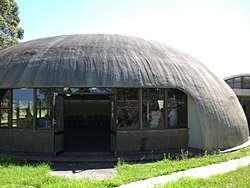Dante Bini
Dante Natale Bini or Dante Bini (1932) is an Italian industrial designer and architect. He is noted for inventing the Binishell, which is a reinforced thin concrete shell structure that can be lifted and shaped by air pressure.[1] He is also considered a pioneer of automated building construction sequences[2] or automated building construction systems.[3]
Dr. Dante Bini | |
|---|---|
| Born | April 22, 1932 Castelfranco Emilia, Italy |
| Nationality | Italian |
| Alma mater | Universita' degli Studi di Firenze (University of Florence) |
| Occupation | Architect |
| Spouse(s) | Adria Moretti |
| Children | Stefano Bini, Nicoló Bini |
| Practice | Bini-Shells, S.p.A. |
| Buildings | Binishell, shell structure |
| Design | automated building construction systems |
Background
Bini was born in 1932 at Castelfranco Emilia, a commune in Emilia-Romagna, Italy.[1] He was the son of Giovanni Bini and Maria Cavallini.
Bini completed liberal studies in Bologna. He then attended the University of Florence and obtained a doctorate in Architecture in 1962.[4] He became influenced by the works of Heinz Isler, Felix Candela, Frei Otto, and Buckminster Fuller.[5]
Bini married Adria Moretti in 1963. In 1981, he immigrated to the United States.[6]
Career
After leaving the University of Florence, Bini became interested in thin-shell concrete domes.[7] He later developed a shell system technology that gave him international recognition.
Binishell
By the 1960s, he started developing a system for inflating concrete domes after experimenting with inflated balloons as formwork.[8] He was able to design a unique pneumatic formwork using a huge low-pressure balloon.[3] This technique was patented in 1964.[6]

In July 1965, he was able to lift his first concrete shell near Bologna. It was a sphere with a 12-meter diameter. By the end of that year, Bini successfully built four such domes.[9] During this period, Bini struggled with several problems, which included the uneven distribution of the wet concrete due to asymmetric inflation.[3] By 1967, improvements were made and Bini demonstrated the prototype - a 12-meter dome constructed in a span of few hours - at the Columbia University in New York.[3][9] This particular construction and those built afterward required helical “springs” reinforced with steel bars to ensure a geometrically controlled inflation, allowing for an even distribution of wet concrete.[3]
From 1970 to 1990, Bini constructed thousands of Binishells around the world, serving different purposes such as homes, schools, sports facilities, and industrial storage units.[7] He stayed for six years in Australia after he was contracted to build Binishells for the Australian government. One of the most notable of these was the Space City Shopping Center in Queensland, which is the world's biggest structure composed of intersecting Binishells.[10] Other Binishells constructed include the Cupola built for Michelangelo Antonioni and Monica Vitti[11] as well as the Binishells built for the Fuji Pavilion during the 1970 Expo at Osaka.[4]
The Binishell technology is also considered a potential solution to housing problems for displaced people, refugees, and evacuees, particularly in areas consistently damaged by disasters.[12] Bini has offered the technology royalty-free to governments and non-governmental organizations (NGOs) that intend to build shelters for these people.[13] The original Binishell has withstood recurring volcanic eruptions and earthquakes on Mount Etna.[12]
Other works
After the Binishell, Bini started developing the so-called Binishelter automated construction method.[2] It uses prefabricated structural components, which is a combination of eight structural or building materials (four for walls and four for roofs) such as wood, concrete, steel, reinforced clay, durock, sheetrock, concrete, bricks, and bamboo.
Bini, together with architect David Dimitric, also designed Shimizu Corporation's Mega-City Pyramid project[14], a proposed vertical city over Tokyo Bay built by robots. This structure, which is intended to address urban congestion, is projected to accommodate from 250,000[15] to 750,000 people[13].
Bini has also invented a movable, self-erecting tent for the U.S. Army.[13]
The architect has participated in initiatives advancing shell-concrete technology such the colloquium at the University of Stuttgart which focused on air and pneumatic structures. [7]
References
- "Dante Bini". architectuul.com. Retrieved 2019-12-04.
- The Binishell. Dwell. 2001. p. 75.
- McLean, Will; Mclean (January 31, 2013). "Skill: Inflatable Concrete Domes". Architectural Review. Retrieved 2019-12-04.
- Ricci, Giulia (July 26, 2019). "Dante Bini and the Moon". Domus. Retrieved 2019-12-06.
- "Architect Bulletin | Binishells in nsw schools". Architect Bulletin. Retrieved 2019-12-04.
- Pugnale, Alberto (2015). "Dante Bini's "New Architectural Formulae": Construction, Collapse and Demolition of Binishells in Australia 1974-2015" (PDF). UNSW. Retrieved December 15, 2019.
- Wouters, Ine; Voorde, Stephanie van de; Bertels, Inge; Espion, Bernard; Jonge, Krista de; Zastavni, Denis (2018). Building Knowledge, Constructing Histories, volume 2: Proceedings of the 6th International Congress on Construction History (6ICCH 2018), July 9-13, 2018, Brussels, Belgium. Boca Raton, FL: CRC Press. p. 925. ISBN 978-0-429-82253-7.
- Unwin, Simon (2019). Curve: possibilities and problems with deviating from the straight in architecture. Oxon: Routledge. p. 85. ISBN 978-1-138-045941.
- Aguilar, Rafael; Torrealva, Daniel; Moreira, Susana; Pando, Miguel A.; Ramos, Luis F. (2018). Structural Analysis of Historical Constructions: An Interdisciplinary Approach. Berlin: Springer. p. 221. ISBN 978-3-319-99440-6.
- Campbell, James; Bill, Nicholas; Draper, Karey; Fleming, Patrick; Pan, Yiting; Andrews, Wendy (2015). Proceedings of the First Conference of the Construction History Society. Exeter: Short Run Press. p. 360. ISBN 978-0-9928751-0-7.
- Shapton, Leanne; Maak, Niklas (2016-07-04). "The House That Love Built — Before It Was Gone". The New York Times. ISSN 0362-4331. Retrieved 2019-12-06.
- Brown, Brigette (2019-02-25). "Can Inflated Concrete "Dome Homes" Help Solve Our Global Housing Crises? - Architizer Journal". Architizer. Retrieved 2019-12-13.
- Future (2005-02-20). "FUTURE / The Architect of Now / Dante Bini addresses our immediate and timely need -- movable, self-erecting shelter". SFGate. Retrieved 2019-12-15.
- Wallace, Andrew (2007). Technocracy: Building a new sustainable society for a post carbon world. Network of European Technocrats. p. 70. ISBN 978-91-633-1249-6.
- Rubenstone, Jeff (November 12, 2014). "Dream Projects: Mega-Pyramid Solves Urban Congestion". ENR. Retrieved 2019-12-13.